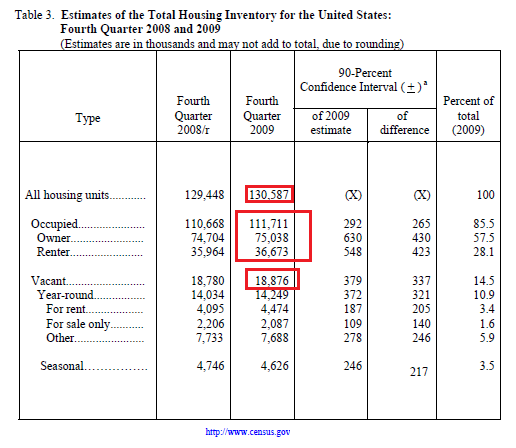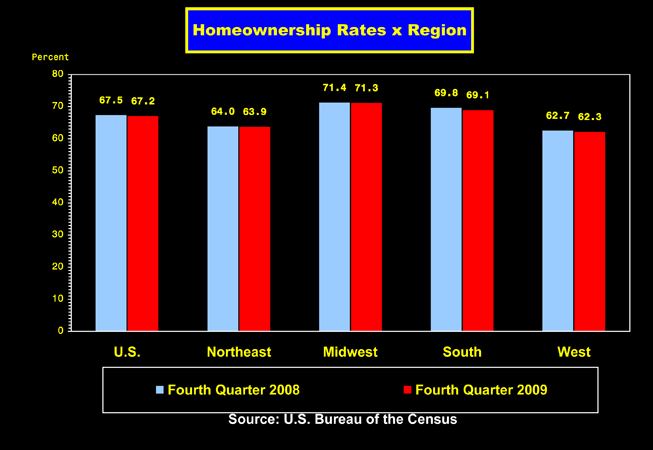The Census Bureau today released the Report on Residential Vacancies and Homeownership. This data covered fourth quarter 2009.
From the release...
- National vacancy rates in the fourth quarter 2009 were 10.7 percent for rental housing and 2.7 percent for homeowner housing.
- The rental vacancy rate was higher than the fourth quarter 2008 rate (10.1 percent) and not statistically different from the rate last quarter (11.1 percent).
- For homeowner vacancies, the current rate was not statistically different from the fourth quarter 2008 rate (2.9 percent) or from the rate last quarter (2.6 percent).
- The homeownership rate at 67.2 percent for the current quarter was not statistically different from the fourth quarter 2008 rate (67.5 percent), but it was lower than last quarter’s rate (67.6 percent).
HOUSING VACANCY AND HOME OWNERSHIP DEFINITIONS
Housing Unit. A housing unit is a house, an apartment, a group of rooms, or a single room occupied or intended for occupancy as separate living quarters. For vacant units, the criteria of separateness and direct access are applied to the intended occupants whenever possible.
The householder refers to the person (or one of the persons) in whose name the housing unit is owned or rented or, if there is no such person, any adult member, excluding roomers, boarders, or paid employees.
Vacant Housing Units. A housing unit is vacant if no one is living in it at the time of the interview, unless its occupants are only temporarily absent. No mention of how a homeowner waiting on an eviction is applied to this data.
At the end of the fourth quarter of 2009, there were 130.58 million housing units in the US. Compare that to the end of 2008 when there were 129.45 million. This is a one year increase of 1.14 million (+0.88%) total housing units.
Of total inventory, 85.5 percent or 111.71 million housing units were occupied.
75.04 million, or 57.5 percent, were owner occupied and 36.67 million, or 28.1 percent, were rented.
18.88 million of 130.58 million housing units were vacant (make sure you read the definition above). This is 14.5% of total housing units.
Of vacant homes:
- 14.25 million were for rent
- 2.09 million were for sale only
- 7.69 million were "other"
Many foreclosures will be in the "other" category, because they are neither for sale or for rent - they are still in the foreclosure process and tied up in legal proceedings, or being held off the market until the legal owner of the property decides what to do. In addition, it is possible the unit could be undergoing repair for future use. Also included in the "vacant other" category are units "for occasional use" and units "temporarily occupied by persons with usual residence elsewhere", both of which may contain foreclosures. Foreclosures could also be included in the seasonal category, depending on the specific situation.

The South had the highest vacancy rates. The rental vacancy in that region was 13.7 percent compared to 13.1 percent in 2008. The rate in the Northeast was the lowest at 7.2 percent but this was an increase over the 6.3 percent reported a year earlier. The homeowner vacancy was also highest in the South at 2.9 percent but this was down slightly from 3.1 percent in 2008. The Northeast had the lowest in this category as well; 1.9 percent compared to 2.2 percent a year earlier.
Ownership is highest among those 65 years of age and over; 80.2 percent are homeowners. The percentage of homeownership declines with each younger age category. Ownership among people under 35 is only 40.4 percent. As might be expected it was also highest among those households with the highest incomes. Where family income was greater than or equal to the median family income the ownership rate was 81.8 percent. This was lower than the 82.9 percent in this category in 2008.








